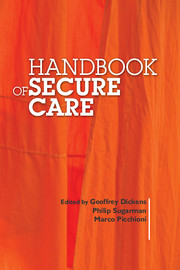Book contents
- Frontmatter
- Contents
- List of tables, boxes and figures
- List of contributors
- Preface
- 1 The evolution of secure and forensic mental healthcare
- 2 Mental disorder and offending
- 3 Clinical risk assessment in secure care
- 4 Risk management in secure care
- 5 Recovery in secure environments
- 6 Personality disorder
- 7 Women's mental health, aggression and offending
- 8 Offenders with intellectual disability in secure services and the criminal justice system
- 9 Secure mental healthcare for young people
- 10 Secure care for people with autism spectrum disorder
- 11 Acquired brain injury, trauma and aggression
- 12 Managing aggression and violence in older people
- 13 Firesetting in secure settings: theory, treatment and management
- 14 Specialist psychological treatment programmes in secure mental healthcare
- 15 Nursing in secure mental healthcare settings
- 16 Prescribing for specialist populations
- 17 Human rights in secure psychiatric care
- 18 Quality assurance and clinical audit in secure psychiatric care
- 19 Psychological support following violent assault and trauma: what works for staff in secure settings?
- Index
12 - Managing aggression and violence in older people
Published online by Cambridge University Press: 02 January 2018
- Frontmatter
- Contents
- List of tables, boxes and figures
- List of contributors
- Preface
- 1 The evolution of secure and forensic mental healthcare
- 2 Mental disorder and offending
- 3 Clinical risk assessment in secure care
- 4 Risk management in secure care
- 5 Recovery in secure environments
- 6 Personality disorder
- 7 Women's mental health, aggression and offending
- 8 Offenders with intellectual disability in secure services and the criminal justice system
- 9 Secure mental healthcare for young people
- 10 Secure care for people with autism spectrum disorder
- 11 Acquired brain injury, trauma and aggression
- 12 Managing aggression and violence in older people
- 13 Firesetting in secure settings: theory, treatment and management
- 14 Specialist psychological treatment programmes in secure mental healthcare
- 15 Nursing in secure mental healthcare settings
- 16 Prescribing for specialist populations
- 17 Human rights in secure psychiatric care
- 18 Quality assurance and clinical audit in secure psychiatric care
- 19 Psychological support following violent assault and trauma: what works for staff in secure settings?
- Index
Summary
Introduction
Historical context
In the past, older people with mental health problems received the same treatment as younger adults. They were admitted to the same hospitals and the same wards. Older mentally disordered offenders who committed serious offences were admitted to hospitals for the criminally insane (East, 1944). In the UK the differentiation of generic mental health services into more specialist clinical services started slowly, but by the 1970s it had gathered enough momentum for both old age psychiatry and forensic psychiatry to split off from general psychiatry and develop along parallel service model lines. This led to the emergence of totally separate in-patient and community services often on geographically separate sites. Despite the obvious advantages of this approach in terms of developing expertise and research, the downside was that older adults were neglected as a group by developing forensic services which concentrated on young men with psychosis. The result was that only 1% of patients newly admitted to high and medium secure beds in England and Wales between 1988 and 1994 were over the age of 60 (Coid et al, 2002). In 1999, I highlighted the paucity of services for older adults and called for greater collaboration between old age and forensic psychiatrists (Yorston, 1999) and over the next few years a number of specialist secure services were established in the independent sector in the UK.
Much of the published research on older offenders includes a preliminary discussion of the issue of age. All figures based on chronological age, however, are arbitrary and it is better to consider age-related needs arising from life-cycle events, multiple physical comorbidities and neurodegenerative disorders, that is biological age rather than chronological age.
Though older patients have some similarities with one another owing to their age, the range of problems they present and their needs are just as varied as those of younger patients. It would be wrong therefore to confine them all together solely on grounds of chronological age.
- Type
- Chapter
- Information
- Handbook of Secure Care , pp. 179 - 192Publisher: Royal College of PsychiatristsPrint publication year: 2015

